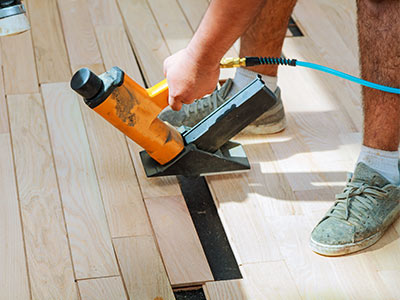Back to Wood Floor Fitting
Nail-Down Floor Installation Explained

For many homeowners and professionals, nailing down or stapling wooden floors is considered the best method for installing hardwood flooring. But is this installation approach ideal for all projects? In this article, we'll explore the key benefits and considerations of nail-down installation.
Nailing or stapling wooden floors is one of the most popular and classic installation methods, widely preferred by professional installers. However, this method can only be applied when the subfloor is made from plywood or OSB (Oriented Strand Board). It’s essential to note that solid wood floorboards typically require longer nails due to their thickness, while engineered wood can be installed using shorter nails. Regardless of the type of flooring, each plank or strip must be nailed every eight to three inches from both ends for optimal stability.
So, if you have a plywood subfloor and plan to install solid or engineered wood, you might wonder if the nail-down method is the best option. Let’s dive into the key benefits.
Why Choose Nail-Down Installation?
1. Cost-Effective Option
One of the primary reasons people opt for the nail-down installation method is its affordability. This method only requires nails or staples, along with a moisture barrier underlayment—both of which are readily available and cost-effective in most flooring stores.
- In comparison, the floating installation method requires a padded underlayment, which tends to be more expensive.
- Similarly, glue-down installations require high-quality wood floor adhesive and the correct trowels, significantly increasing costs.
In both cases, the extra materials add to the overall expense, making the nail-down method a more budget-friendly choice.
2. Long-Lasting Durability
The nail-down installation method is known for its permanence. When installed correctly and paired with proper maintenance, this method ensures your wooden floor lasts practically forever. The risk of loose boards or nail heads popping up is minimal, offering peace of mind.
Even in rare cases of damage, spot repairs are possible. You can replace individual boards without having to overhaul the entire floor, making it an efficient and cost-effective solution for maintaining both the appearance and structural integrity of your floor.
3. Tolerance for Uneven Subfloors
One challenge in any wood floor installation is dealing with uneven subfloors. Subfloor imperfections can cause issues with certain installation methods, but with the nail-down approach, there is greater tolerance for slight irregularities.
- If your subfloor isn’t perfectly flat, the nail-down method can still provide a smooth and secure installation.
- In contrast, methods like floating or glue-down installations may require more extensive subfloor preparation.
This flexibility makes the nail-down method more forgiving, allowing you to enjoy a beautiful wood floor even when your subfloor isn’t perfectly level.
4. Seamless Transitions
Another significant advantage of the nail-down method is the ability to achieve flush mount transitions between rooms or areas. Unlike floating floors, which require overlapping transition mouldings and vents, the nail-down approach allows for flush-in transition mouldings. This gives the floor a cleaner, more refined appearance, enhancing the overall aesthetic appeal of your space.
Considerations for DIY Installers
While the nail-down method offers many advantages, it also requires a significant amount of tools and equipment. If you're considering a DIY installation, you will need specialised tools such as:
- Flooring nail gun
- Jamb saw
- Router, and more.
This can add to the cost, especially if you don’t already own these tools. However, investing in high-quality equipment is essential to achieving a successful installation. Ensuring the use of a reliable flooring nail gun or stapler is key to achieving secure, long-lasting results.
Conclusion
The nail-down installation method remains one of the most popular choices for both solid and engineered wood flooring due to its affordability, durability, and versatility. With the added tolerance for uneven subfloors and the ability to create seamless transitions, this method offers a clean and long-lasting solution for hardwood flooring. However, if you're considering a DIY project, it’s crucial to have the right tools at your disposal to achieve the best results.
Considering a nail-down wood floor installation? This classic method offers unmatched durability and a solid feel underfoot—when done right. Trust our experienced team at FlooringFirst! for expert advice and precision fitting. Book a free site visit or contact us today to discuss your project and flooring goals.